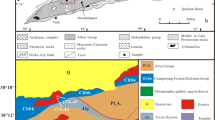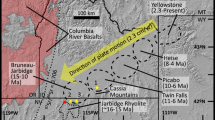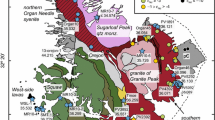Abstract
Recent advances in U–Pb geochronology allow unprecedented levels of precision in the determination of geological ages. However, increased precision has also illuminated the importance of understanding subtle sources of open-system behavior such as Pb-loss, inheritance, intermediate daughter product disequilibria, and the accuracy of the model assumptions for initial Pb. Deconvolution of these effects allows a much richer understanding of the power and limitations of U–Pb geochronology and thermochronology. In this study, we report high-precision ID-TIMS U–Pb data from zircon, baddelleyite, titanite and apatite from the McClure Mountain syenite, from which the 40Ar/39Ar hornblende standard MMhb is derived. We find that excess 206Pb in zircon due to inclusions of high-Th minerals and elevated Th/U in titanite and apatite jeopardize the utility of the 238U–206Pb system in this rock. Strongly air-abraded zircons give dates that are younger than chemical-abraded zircons, which yield a statistically robust 207Pb/235U date of 523.98±0.12 Ma that is interpreted as the crystallization age. We explore the best method of Pbc correction in titanite and apatite by analyzing the U–Pb isotopes of K-feldspar and using 2-D and 3-D regression methods—the latter of which yields the best results in each case. However, the calculated compositions of Pbc for titanite, apatite and K-feldspar are different, implying that using a single Pbc correction for multiple U–Pb thermochronometers may be inaccurate. The U–Pb thermochronological results are used to predict a closure time for Ar in hornblende of 522.98±1.00 Ma. Widely cited K–Ar and 40Ar/39Ar dates overlap with the U–Pb date, and relatively large errors make it impossible to verify whether U–Pb dates are systematically ≤1% older than K–Ar and 40Ar/39Ar dates.










Similar content being viewed by others
References
Alexander JEC, Mickelson GM, Lanphere MA (1978) MMhb-1: a new 40Ar-39Ar dating standard. In: Zartman RE (ed) Short papers of the fourth international conference, geochronology, cosmochronology, and isotope geology, vol 78–701. US Geological Survey, Open-File report, pp 6–8
Amelin Y, Zaitsev AN (2002) Precise geochronology of phoscorites and carbonatites: the critical role of U-series disequilibrium in age interpretations. Geochim Cosmochim Acta 66(13):2399–2419
Anczkiewicz R, Oberli F, Burg JP, Villa IM, Gunther D, Meier M (2001) Timing of normal faulting along the Indus Suture in Pakistan Himalaya and a case of major 231Pa/235U initial disquilibrium in zircon. Earth Planet Sci Lett 191:101–114
Armbrustmacher TJ, Hedge CE (1982) Genetic implications of minor-element and Sr-isotope geochemistry of alkaline rock complexes in the Wet Mountains area, Fremont and Custer counties, Colorado. Contrib Miner Petrol 79:424–435
Baksi AK, Archibald DA, Farrar E (1996) Intercalibration of 40Ar/39Ar dating standards. Chem Geol 129:307–324
Begemann F, Ludwig KR, Lugmair GW, Min K, Nyquist LE, Patchett PJ, Renne PR, Shih C-Y, Villa IM, Walker RJ (2001) Call for an improved set of decay constants for geochronological use. Geochim Cosmochim Acta 65(1):111–121
Chamberlain KR, Bowring SA (2000) Apatite–feldspar U–Pb thermochronometer: a reliable mid-range (~450˚C), diffusion controlled system. Chem Geol 172:173–200
Cherniak DJ (1993) Lead diffusion in titanite and preliminary results on the effects of radiation damage on Pb transport. Chem Geol 110:177–194
Cherniak DJ (1995) diffusion of Pb in plagioclase and K-feldspar investigated using Rutherford backscatter and resonant nuclear reaction analysis. Contrib Miner Petrol 120:358–371
Cherniak DJ, Watson EB (2000) Pb diffusion in rutile. Contrib Miner Petrol 139:198–207
Cherniak DJ, Lanford WA, Ryerson FJ (1991) Lead diffusion in apatite and zircon using ion implantation and Rutherford Backscattering techniques. Geochim Cosmochim Acta 55:1663–1673
Corfu F (1988) Differential response of U–Pb systems in coexisting accessory minerals, Winnepeg River Subprovince, Canadian Shield: implications for Archean crustal growth and stabilization. Contrib Mineral Petrol 98:312–325
Corfu F, Stone D (1998) The significance of titanite and apatite U–Pb ages: Constraints for the post-magmatic thermal–hydrothermal evolution of a batholithic complex, Berens River area, northwestern Superior Province, Canada. Geochim Cosmochim Acta 62(17):2979–2995
Corfu F, Hanchar JM, Hoskin PWO, Kinny P (2003) Atlas of zircon textures. In: Hanchar JM, Hoskin PWO (eds) Zircon, vol 53. Mineralogical Society of America, Washington, D.C., pp 468–500
Dahl PS (1997) A crystal-chemical basis for Pb retention and fission-track annealing systematics in U-bearing minerals, with implications for geochronology. Earth Planet Sci Lett 150:277–290
Dodson MH (1973) Closure temperature in cooling geochronological and petrological systems. Contrib Mineral Petrol 40:259–274
Dodson MH (1986) Closure profiles in cooling systems. Mater Sci Forum 7:145–154
Fenn PM (1986) On the origin of graphic granite. Amer Min 71:325–330
Frost BR, Chamberlain KR, Schumacher JC (2000) Sphene (titanite): phase relations and role as a geochronometer. Chem Geol 172:131–148
Gerstenberger H, Haase G (1997) A highly effective emitter substance for mass spectrometric Pb isotope ratio determinations. Chem Geol 136:309–312
Grove M, Harrison TM (1996) 40Ar* diffusion in Fe-rich biotite. Amer Mineral 81:940–951
Hanchar JM, Hoskin PWO (2003) Reviews in mineralogy and geochemistry: zircon, vol 53. The Mineralogical Society of America, Washington
Harrison TM (1981) Diffusion of 40Ar in hornblende. Contrib Miner Petrol 78:324–331
Harrison TM, Duncan I, McDougall I (1985) Diffusion of 40Ar in biotite; temperature, pressure and compositional effects. Geochim Cosmochim Acta 49:2461–2468
Housh T, Bowring SA (1991) Lead isotopic heterogeneities within alkali feldspars: implications for the determination of initial lead isotopic compositions. Geochim Cosmochim Acta 55:2309–2316
Jaffey AH, Flynn KF, Glendenin LE, Bentley WC, Essling AM (1971) Precision measurement of half-lives and specific activities of 235U and 238U. Phys Rev C4:1889–1906
Joesten R (1992) Grain-boundary diffusion kinetics in silicate and oxide minerals. In: Ganguly J (ed) Diffusion, atomic ordering, and mass transport, vol 8. Springer, Berlin Heidelberg New York, pp 345–395
Krogh TE (1973) A low contamination method for hydrothermal decomposition of zircon and extraction of U and Pb for isotopic age determination. Geochim Cosmochim Acta 37:485–494
Krogh TE (1982) Improved accuracy of U–Pb zircon ages by the creation of more concordant systems using an air abrasion technique. Geochim Cosmochim Acta 46:637–649
Kunk MJ, Miller AP (2002) Completion of NIST calibration of argon spikes, and plans for interlaboratory calibration of MMhb-2. Geol Soc Amer Abs w Prog 34:340
Kunk MJ, Dalrymple GB, Snee LW (1994) Progress on the preparation of the proposed 40Ar/39Ar standard MMhb-1, plans for its calibration, and interlaboratory calibration of argon facilities. USGS Circ. In: Abstracts of the 8th international conference on geochronology, cosmochronology and isotope geology, 1107:183
Lee JKW, Onstott TC, Cashman KV, Cumbest RJ, Johnson D (1991) Incremental heating of hornblende in vacuo: implications for 40Ar/39Ar geochronology and the interpretation of thermal histories. Geology 19:872–876
Loferski PJ, Ayuso RA (1995) Petrography and mineral chemistry of the composite Deboullie pluton, northern Maine, USA.: implications for the genesis of Cu–Mo mineralization. Chem Geol 123:89–105
Lofgren G (1980) Experimental studies on the dynamic crystallisation of silicate melts. In: Hargraves RB (ed) Physics of magmatic processes vol. Princeton University Press, New Jersey, pp 487–551
Ludwig KR (1980) Calculation of uncertainties of U–Pb isotope data. Earth Planet Sci Lett 46:212–220
Ludwig KR (1991) Isoplot–a plotting and regression program for radiogenic isotope data. USGS Open-File report 91–445
Ludwig KR (1998) On the treatment of concordant uranium–lead ages. Geochim Cosmochim Acta 62(4):665–676
Mattinson JM (1973) Anomalous isotopic composition of lead in young zircons. Carnegie Inst Yearbook 72:613–616
Mattinson JM (1987) U–Pb ages of zircons: a basic examination of error propagation. Chem Geol 66:151–162
Mattinson JM (1994) Uranium decay constant uncertainties and their implications for high-resolution U–Pb geochronology. GSA Abstr Prog 77:A-221
Mattinson JM (2000) Revising the “gold standard”—the uranium decay constants of Jaffey et al. 1971. Eos Trans. AGU, Spring Meet. Suppl., Abstract V61A–02
Mattinson JM (2003) CA (chemical abrasion)-TIMS: high-resolution U–Pb zircon geochronology combining high-temperature annealing of radiation damage and multi-step partial dissolution analysis. Eos Trans. AGU, Fall Meet. Suppl., Abstract V22E–06
Mattinson JM (2005) Zircon U–Pb chemical-abrasion (“CA-TIMS”) method: combined annealing and multi-step dissolution analysis for improved precision and accuracy of zircon ages. Chem Geol 220(1–2):47–56
McDougall I, Harrison TM (1999) Geochronology and thermochronology by the 40Ar/39Ar method, Oxford University Press, New York
Meurer WP, Boudreau AE (1996) An evaluation of models of apatite compositional variability using apatite from the Middle Banded series of the Stillwater Complex, Montana. Contrib Miner Petrol 125:225–236
Mezger K, Cosca MA (1999) The thermal history of the Eastern Ghats Belt (India) as revealed by U–Pb and 40Ar/39Ar dating of metamorphic and magmatic minerals: implications for the SWEAT correlation. Precam Res 1999:251–271
Mezger K, Rawnsley CM, Bohlen SR, Hanson GN (1991) U–Pb garnet, sphene, monazite, and rutile ages: implications for the duration of high-grade metamorphism and cooling histories, Adirondack, Mts., New York. J Geol 99:415–428
Min K, Mundil R, Renne PR, Ludwig KR (2000) A test for systematic errors in 40Ar/39Ar geochronology through comparison with U–Pb analysis of a 1.1 Ga rhyolite. Geochim Cosmochim Acta 64:73–98
Min K, Renne PR, Huff WD (2001) 40Ar/39Ar dating of Ordovician K-bentonites in Laurentia and Baltoscandia. Earth Planet Sci Lett 185:121–134
Mortensen JK, Roddick JC, Parrish RR (1992) Evidence for high levels of unsupported radiogenic 207Pb in zircon from a granitic pegmatite: implications for interpretation of discordant U–Pb data. EOS, Trans Amer Geophys Union 73:370
Nemchin AA, Pidgeon RT (1999) U–Pb ages on titanite and apatite from the Darling Range granite: implications for Late Archean history of the southwestern Yilgarn Craton. Precam Res 96:125–139
Oberli F, Meier M, Berger A, Rosenburg CL, Giere R (2004) U–Th–Pb and 230Th/238U disequliibrium isotope systematics: precise accessory mineral chronology and melt evolution tracing in the Apline Bergell intrusion. Geochim Cosmochim Acta 68:2543–2560
Olson JC, Marvin RF, Parker RL, Mehnert HH (1977) Age and tectonic setting of lower Paleozoic alkalic and mafic rocks, carbonatites and thorium veins in south-central Colorado. Jour Res US Geol Survey Bull 5(6):673–687
Parker RL, Hildebrand FA (1963) Preliminary report on alkalic intrusive rocks in the northern Wet Mountains, Colorado. US Geol Survey Prof Paper 450-E:E8–E10
Parrish RR (1990) U–Pb dating of monazite and its application to geological problems. Can J Earth Sci 27:1431–1450
Pidgeon RT, Nemchin AA, Hitchen GJ (1998) Internal structures of zircons from Archean granites from the Darling Range batholith: implications for zircon stability and the interpretation of zircon U–Pb ages. Contrib Miner Petrol 132:288–299
Rasmussen B, Fletcher IR (2004) Zirconolite: a new U–Pb chronometer for mafic igneous rocks. Geology 32(9):785–788
Reid MR, Coath CD (2000) In situ U–Pb ages of zircons from the Bishop Tuff: no evidence for long crystal residence times. Geology 28:443–446
Reid MR, Coath CD, Harrison TM, McKeegan KM (1997) Prolonged residence times for the youngest rhyolites associated with Long Valley caldera: ion microprobe dating of young zircons. Earth Planet Sci Lett 150:27–38
Renne PR (2000) 40Ar/39Ar age of plagioclase from Acapulco meteorite and the problem of systematic errors in cosmochronology. Earth Planet Sci Lett 175:13–26
Renne PR, Karner DB, Ludwig KR (1998a) Absolute ages aren’t exactly. Science 282:1840–1841
Renne PR, Swisher CC, Deino AL, Karner DB, Owens TL, DePaolo DJ (1998b) Intercalibration of standards, absolute ages and uncertainties in 40Ar/39Ar dating. Chem Geol 145:117–152
Rex DC, Guise PG, Wartho J-A (1993) Disturbed 40Ar–39Ar spectra from hornblendes: Thermal loss or contamination. Chem Geol 103:271–281
Samson SD, Alexander JEC (1987) Calibration of the interlaboratory 40Ar–39Ar dating standard, MMhb–1. Chem Geol 66:27–34
Schmitz MD, Bowring SA (2001) U–Pb zircon and titanite sytematics of the Fish Canyon Tuff: an assessment of high-precision U–Pb geochronology and its application to young volcanic rocks. Geochim Cosmochim Acta 65(15):2571–2587
Schmitz MD, Bowring SA (2003) constraints on the thermal evolution of continental lithosphere from U–Pb accessory mineral thermochronometry of lower crustal xenoliths, southern Africa. Contrib Miner Petrol 144:592–618
Schmitz MD, Bowring SA, Ireland TR (2003) Evaluation of Duluth Complex anorthositic series (AS3) zircon as a U–Pb geochronological standard: new high-precision isotope dilution thermal ionization mass spectrometry results. Geochim Cosmochim. Acta 67(19):3665–3672
Schoene B, Crowley JL, Condon DC, Schmitz MD, Bowring SA (2006) Reassessing the Uranium decay constants for geochronology using ID-TIMS U–Pb data. Geochim Cosmochim Acta 70:426–445
Schärer U (1984) The effect of initial 230Th disequilibrium on young U–Pb ages: the Makalu case, Himalaya. Earth Planet Sci Lett 67:191–204
Schön R, Winkler G, Kutschera W (2004) A critical review of experimental data for the half-lives of the uranium isotopes 238U and 235U. Appl Radiat Isot 60:263–273
Shawe DR, Parker RL (1967) Mafic-ultramafic layered intrusion at Iron Mountain, Fremont County, Colorado. US Geol Survey Bull 1251-A:A1–A20
Spell TL, McDougall I (2003) Characterization and calibration of 40Ar/39Ar dating standards. Chem Geol 198:189–211
Stacey JC, Kramers JD (1975) Approximation of terrestrial lead isotope evolution by a two-stage model. Earth Planet Sci Lett 26:207–221
Steiger RH, Jäger E (1977) Subcommission on Geochronology: convention on the use of decay constants in geo- and cosmochronology. Earth Planet Sci Lett 36:359–362
Verts LA, Chamberlain KR, Frost CD (1996) U–Pb sphene dating of metamorphism: the importance of sphene growth in the contact aureole of the Red Mountain pluton, Laramie Mountains, Wyoming. Contrib Miner Petrol 125:186–199
Villa IM, Grobéty B, Kelley SP, Trigila R, Wieler R (1996) Assessing Ar transport paths and mechanisms in the McClure Mountains hornblende. Contrib Miner Petrol 126:67–80
Willmore CC, Boudreau AE, Kruger FJ (2000) The halogen geochemistry of the Bushveld Complex, Republic of South Africa: implications for chalcophile element distribution in the lower and critical zones. J Petrol 41:1517–1539
York D (1969) Least-squares fitting of a straight line with correlated errors. Earth Planet Sci Lett 5:320–324
Acknowledgments
Helpful reviews by J. Hanchar and an anonymous reviewer made this an overall better paper. This work was supported in part by NSF grant EAR 0451802 (The EARTHTIME Network: Developing an infrastructure for high-resolution calibration of Earth History) to S. Bowring. Additional support was provided to B. Schoene by a subaward from NSF grant EAR 031521 (CHRONOS to C. Cervato).
Author information
Authors and Affiliations
Corresponding author
Additional information
Communicated by T. L. Grove
Rights and permissions
About this article
Cite this article
Schoene, B., Bowring, S.A. U–Pb systematics of the McClure Mountain syenite: thermochronological constraints on the age of the 40Ar/39Ar standard MMhb. Contrib Mineral Petrol 151, 615–630 (2006). https://doi.org/10.1007/s00410-006-0077-4
Received:
Accepted:
Published:
Issue Date:
DOI: https://doi.org/10.1007/s00410-006-0077-4




